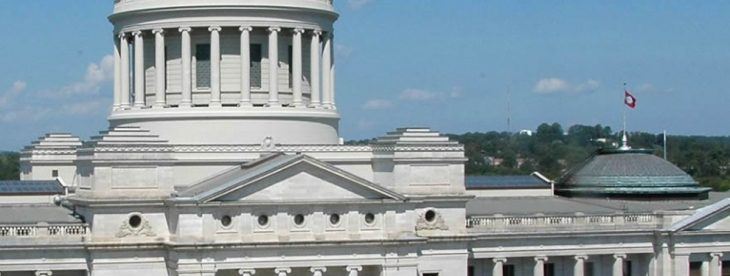State lawmakers close out budget for 2017 session, concerns about budget shortfall noted
by March 29, 2017 3:23 pm 526 views

Arkansas lawmakers on Wednesday put the final touches on the state’s overall budget for fiscal 2018, including setting aside millions of dollars in expected surplus funds for the governor’s Quick Action Closing Fund, shared executive and legislative priorities, and the state’s rainy day fund.
The Joint Budget Committee, made up of House and Senate members, closed out its work in short fashion in a morning meeting at the State Capitol. Lawmakers are expected to wind down the 91st General Assembly by Monday. The session convened on Jan. 9.
According to details of the proposed $5.49 billion biennial budget lawmakers reviewed and approved this week, the total estimated carryover from the general improvement act in 2015 is $239.4 million. The forecasted surplus for fiscal 2017, which ends on June 30, is $177.4 million.
Other one-time funds that will carry over into the new two-year budget period are $14.1 million in unobligated funds and $35 million in rainy funds from the 2015 session. An additional $13 million will be recouped from general revenue balances in fiscal 2016 and 2017 and leftover monies from past state projects.
Still, some lawmakers expressed concerns that revenue collections for the remainder of the fiscal year will come in below forecast, causing state budget officials to recalibrate the remaining available funds that will be set aside for executive and legislative projects. Rep. Stephen Meeks, R-Greenbrier, posed several questions to Department of Finance and Administration budget officials concerning the end-of-the-year forecast. Specifically, Meeks worried about the March revenue picture because tax collections in the previous two months were below expectations.
“The question I had is if the revenue we had in January and February were down below forecast, I wanted to see if you could give us an idea of where you might think we would end up in March and for the rest of the fiscal year?” Meeks asked.
DFA Deputy Director Paul Louthian, who appeared before the legislative panel with state economist John Shelnutt, guarded his comments concerning a possible budget shortfall for the rest of fiscal 2017.
“At this time I cannot give you an estimate of where we will be at the end of the year, but … it appears that the revenues for March will be below forecast,” Louthian said, adding that the upcoming monthly report will likely be impacted negatively by corporate tax filing dates changed by the Internal Revenue Service.
Sen. Larry Teague, D-Nashville, co-chair of the joint legislative panel, also responded publicly to Meeks’ query by saying, “I will say that the revenue for March is not positive.”
The March revenue report will be released next week, DF&A officials said.
In February, DF&A reported that net available general revenue in February came in at $276.7 million, $3.2 million or 1.2% below last year and $40.9 million or 17.3% above forecast. Year-to-date net available general revenues totaled $3.43 billion, $19 million or 0.6% above year ago levels. Today, with only four months left in the fiscal year, net available revenue is below forecast by $15 million or a decline of 0.4%.
Gov. Asa Hutchinson laid out a $5.5 billion budget for the state through fiscal year 2018 in November, highlighting his tax cut proposals, efficiency measures and economic development and education initiatives.
As part of negotiations with the Hutchinson administration and state fiscal officers, the joint legislative panel is tasked with laying out the state’s operating budget through the Revenue Stabilization Act before the session can end. In the budget allocations laid out Wednesday for fiscal 2018, the Department of Education’s Public School Fund will get the biggest slice of the fiscal 2019 budget with an outlay of $2.19 billion, essentially the same as the previous year.
The second largest allocation will go to the Department of Human Services at $1.55 billion, up 7.6% from the previous year. At $588.1 million, the state-supported four-year colleges and universities 2018 fiscal budget is exactly the same as the prior year, while two-year colleges across the state will also see the same budget allocation from the previous year at $111.9 million.
Of the $239.4 million expected to remain at the end of the fiscal year, more than $160 million will pay down mandatory state debt and $14 million will go to DHS’s Children and Family Services unit to provide extra funding for the state’s crisis-plagued foster care system. At the beginning of the session, Gov. Hutchinson proposed $26 million in fiscal year 2018 and $11 million in fiscal year 2019 to fund 228 additional staff members at DHS’ foster care division, including 150 new caseworkers.
After that, nearly $65 million will be distributed for shared project funding between the executive and legislative branches, including $32 million for the governor’s Quick Action Closing Fund and other economic development drivers and $20 million to the Highway Transfer Fund to help the state receive matching federal dollars for short-term highway needs.
The remaining $12.9 million will go into the state’s rainy day fund, a discretionary account that the governor may use for emergencies such as a superproject. Under state law, the rainy day fund balance can’t exceed $125 million.
